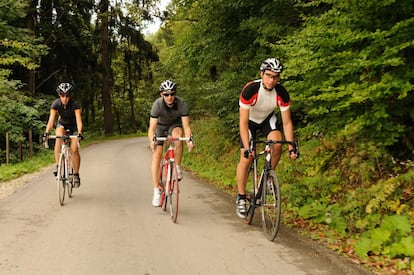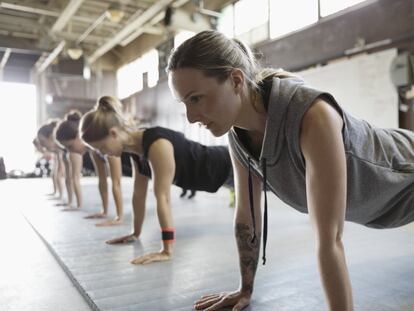Physical activity may protect against respiratory infections
Scientific studies indicate that people who do aerobic and strength exercises have a lower risk of dying from pneumonia and influenza


The health benefits of physical activity are well established. It reduces the risk of cardiovascular disease, diabetes and several types of cancer, including breast and kidney cancer. It also increases life expectancy and helps combat depression and anxiety. There is evidence now that higher levels of physical activity are associated with a lower incidence and milder acute respiratory infection (ARIs) symptoms.
ARIs such as the common cold, pneumonia, influenza, Covid-19 and bronchitis are the world’s most prevalent diseases and cause the highest mortality levels, according to a 2022 review of scientific studies published in the Journal of Sport and Health Science. The report states that adults who engage in moderate to vigorous physical activity have a 36-40% lower risk of dying from these diseases. People participating in aerobic and strength exercises and sports have a 54% lower risk of dying from pneumonia or influenza.
Dr. Pablo Berenguel, who leads the Sports Medicine Working Group of the Spanish Society of General and Family Practitioners (SEMG), says that children suffer around five upper respiratory tract infections yearly, and adults only have two or three. According to the study, these diseases are among the four leading causes of death and disability in children and adults worldwide. Dr. Rosario Menéndez, head of pneumology at La Fe Hospital in Valencia (Spain), says they are the leading cause of death from infections worldwide.
In January, a study published in Pediatric Research used pedometers to track the physical activity of 110 children between the ages of four and seven. The more active group observed a lower prevalence of respiratory infections, and their symptoms were milder and shorter than children who exercised less. A change in the average number of steps per day by 1,000 changed the number of days with symptoms by four days. This outcome was even more pronounced in children who exercised regularly.
Dr. Manuel Praena, a member of the Respiratory Group of the Spanish Association of Primary Care Pediatrics (AEPAP), was not involved in the study but thinks it opens up some interesting research possibilities. Praena says children suffer the most from these infections because they have more immature immune systems. If these infections worsen, they can lead to other pathologies, such as otitis (inflammation of the external ear canal).
Dr. Rosario Menéndez, a member of the Spanish Society of Pneumology and Thoracic Surgery (SEPAR), says that two factors can explain the study’s findings. “Physical activity improves immune system responses and promotes anti-inflammatory activity in the body.” She also says it helps counteract immunosenescence, a process of immune dysfunction that occurs with age. The immune system becomes less effective with age, and exercise “helps get it back in shape.” Moderate exercise boosts the body’s defenses and reduces the incidence and severity of infections, especially respiratory ones, says Dr. Berenguel.
A study of 2,690 older adults in the United Kingdom, published in PLOS ONE in 2021, showed that those who had moderate-to-high levels of cardiorespiratory fitness (the ability to perform an exercise at a certain intensity level and duration) had a significantly lower risk of death from Covid-19 than those with low levels of cardiorespiratory fitness.
Overall, the 2022 scientific literature review found a robust reduction in the risk of serious Covid-19 in people with high cardiorespiratory fitness levels and in people who followed recommended physical activity guidelines and avoided sedentary lifestyles.
How much should we exercise?
The World Health Organization (WHO) has reported that one in four adults and 80% of teenagers fail to achieve the recommended level of physical activity. The WHO recommends that children between the ages of five and 17 spend at least one hour a day doing moderate to vigorous aerobic physical activity. The WHO recommendation for people between the ages of 18 and 64 is at least 150-300 minutes per week.
Dr. Pablo Berenguel says that medical guidelines recommend regular physical activity for patients with respiratory diseases at an intensity level that still allows them to talk while exercising. The medical guidelines also warn that anaerobic exercise (shorter, more intense exercise) requires large amounts of oxygen all at once, which lowers blood oxygen levels already depleted by the respiratory infection.
Aerobic activity helps people with respiratory conditions to alleviate the sensation of breathlessness and achieve higher levels of physical activity, says Berenguel. In contrast, resistance training helps increase muscle mass and strength. When combined, people have less severe illnesses and are better able to perform daily tasks. They also live longer, more healthy lives.
Sign up for our weekly newsletter to get more English-language news coverage from EL PAÍS USA Edition.
Tu suscripción se está usando en otro dispositivo
¿Quieres añadir otro usuario a tu suscripción?
Si continúas leyendo en este dispositivo, no se podrá leer en el otro.
FlechaTu suscripción se está usando en otro dispositivo y solo puedes acceder a EL PAÍS desde un dispositivo a la vez.
Si quieres compartir tu cuenta, cambia tu suscripción a la modalidad Premium, así podrás añadir otro usuario. Cada uno accederá con su propia cuenta de email, lo que os permitirá personalizar vuestra experiencia en EL PAÍS.
¿Tienes una suscripción de empresa? Accede aquí para contratar más cuentas.
En el caso de no saber quién está usando tu cuenta, te recomendamos cambiar tu contraseña aquí.
Si decides continuar compartiendo tu cuenta, este mensaje se mostrará en tu dispositivo y en el de la otra persona que está usando tu cuenta de forma indefinida, afectando a tu experiencia de lectura. Puedes consultar aquí los términos y condiciones de la suscripción digital.
More information
Archived In
Últimas noticias
Cilia Flores, the power behind the Venezuelan throne
Cuba confirms death of 32 of its citizens in the US attack against Venezuela
Alvin Hellerstein, a 92-year-old judge appointed by Bill Clinton, to preside over Maduro’s trial in New York
Venezuela is foreshadowing the new world order that Trump wants to impose
Most viewed
- Gilles Lipovetsky: ‘If you want to live better and fall in love, take Prozac, don’t look to philosophy’
- Alain Aspect, Nobel laureate in physics: ‘Einstein was so smart that he would have had to recognize quantum entanglement’
- Maduro’s downfall puts China’s relationship with Venezuela to the test
- Why oil has been at the center of Venezuela-US conflicts for decades
- The US bombing of Venezuela, in pictures









































